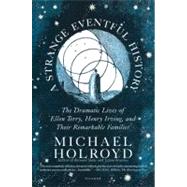
Note: Supplemental materials are not guaranteed with Rental or Used book purchases.
Purchase Benefits
What is included with this book?
| List of Illustrations | p. xii |
| Notes on the Text and Acknowledgements | p. xvi |
| Rumours of a Death Foretold | p. 1 |
| A Story in a Book | p. 5 |
| The Terrys | p. 8 |
| Mirror, Mirror, on the Wall | p. 16 |
| Heaven and Holland Park | p. 22 |
| England's Michelangelo | p. 26 |
| The Kingdom of Pattledom | p. 29 |
| A Marriage Is Arranged and a Deed of Separation Signed | p. 35 |
| The Kate Terry Valse | p. 47 |
| Found Drowned | p. 52 |
| Happiness for a Time | p. 54 |
| All Change | p. 63 |
| A Failure to Be Proud Of | p. 66 |
| Men! | p. 79 |
| What's in a Name? | p. 91 |
| Entrances and Exits | p. 98 |
| Their Coronation | p. 108 |
| Our Lady of the Lyceum | p. 119 |
| Interval: Irving on Holiday | p. 127 |
| His Shylock | p. 129 |
| Shakespeare's Lovers | p. 135 |
| Children! | p. 143 |
| Our American Cousins | p. 158 |
| From Malvolio to Mephistopheles | p. 170 |
| Death of a Husband, Death of a Lover | p. 179 |
| Her Lady Macbeth | p. 193 |
| Ted and Edy and Harry and Laurence | p. 202 |
| All Is True | p. 220 |
| After the Shooting | p. 227 |
| Counter Attractions | p. 234 |
| One More Laurel Wreath | p. 243 |
| Mixed Fortunes | p. 247 |
| The Irish Pretender | p. 266 |
| Wishful Thinking | p. 276 |
| Choices | p. 284 |
| Confusions | p. 295 |
| For Love or Money | p. 303 |
| Made in Heaven | p. 321 |
| A Sea of Troubles: Helgeland and Hungerheart | p. 333 |
| The End of Irving | p. 354 |
| Women! | p. 367 |
| Brothers | p. 392 |
| Family Affairs | p. 409 |
| Masks and Faces | p. 435 |
| Not Quite Alone | p. 470 |
| The Long Game of Patience | p. 478 |
| An Occasion | p. 493 |
| For Friendship's Sake | p. 513 |
| Good Night Unto You All | p. 531 |
| White Candle, Aged Face | p. 553 |
| An Outline of Sources | p. 575 |
| Select Bibliography | p. 585 |
| Index | p. 591 |
| Table of Contents provided by Ingram. All Rights Reserved. |
The New copy of this book will include any supplemental materials advertised. Please check the title of the book to determine if it should include any access cards, study guides, lab manuals, CDs, etc.
The Used, Rental and eBook copies of this book are not guaranteed to include any supplemental materials. Typically, only the book itself is included. This is true even if the title states it includes any access cards, study guides, lab manuals, CDs, etc.
Excerpted from A Strange Eventful History. By Michael Holroyd.
Copyright © 2009 by Michael Holroyd.
Published in the United States by Farrar, Straus and Giroux in hardcover, and by Picador in trade paperback.
All rights reserved. This work is protected under copyright laws and reproduction is strictly prohibited. Permission to reproduce the material in any manner or medium must be secured from the publisher.